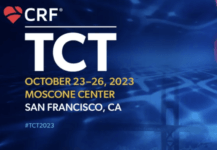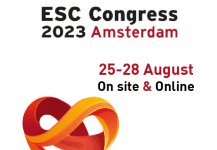In recent times, pulmonary thromboembolism (PTE) has been the subject of growing research due to its persistent impact on morbidity and mortality. Acute PTE, if not properly treated or inadequately treated, can lead to a debilitating condition known as post-PTE syndrome, which has been documented in nearly 50% of survivors. The primary treatment strategy for…
TCT 2023 | COMPARE 60/80 HBR TRIAL
This was a randomized study including patients at high risk of bleeding treated with short dual antiplatelet therapy (DAPT). A total 747 patients were recruited, 368 received PCI with the ultrathin Superflex stent with 60 µm struts (SUF), and 364 received the Terumo Tansei with 89 µm struts (SF). Primary end point was NACE at…
TCT 2023 | T-PASS TRIAL, ASA and Ticagrelor in Acute Coronary Syndrome
This is a multicenter randomized study including 2,850 patients with acute coronary syndrome. Patients were randomized to: dual antiplatelet therapy (DAPT) with ASA and ticagrelor during one month (1,426 patients), followed by ticagrelor monotherapy for 12 months, while the other group received DAPT with ASA and ticagrelor during 12 months (1,424 patients). This study was…
Anti-Lipid Therapy in PCI Patients: Monotherapy with Statins or Combination?
According to several studies, in patients with high-risk atherosclerotic disease, such as those affected by coronary artery disease, achieving target LDL levels through high-intensity statin therapy has been shown to lead to a significant reduction in long-term cardiovascular events. Therefore, the management of dyslipidemia has become a fundamental pillar of secondary prevention. However, reaching such…
Substudy TALOS AMI: from Ticagrelor to Clopidogrel in Patients with High Risk of Bleeding and AMI
The preference for the use of potent P2Y12 inhibitors such as ticagrelor and prasugrel in patients with high risk of acute myocardial infarction (AMI) undergoing percutaneous coronary intervention (PCI) is based on randomized studies and current guideline recommendations. However, clopidogrel is still recommended for patients at high risk of bleeding. Several strategies have been looked…
ESC 2023 | Anticoagulation After Primary PCI in STEMI Patients
The empirical prescription of anticoagulants after percutaneous coronary intervention (PCI), also know as post-procedural anticoagulation (PPA), is nowadays a common practice that uses various types of medications. Despite studies like HORIZONS-AMI and EUROMAX, in which 41% of patients received PPA, and the CCC-ACS registry, where 75% of subjects received PPA after primary PCI, European and…
ESC 2023 | Extended Monotherapy with Clopidogrel vs. DAPT in High-Risk Patients
An increasing number of patients currently present both an elevated ischemic risk and hemorrhagic risk. This means that the selection of the optimal antiplatelet treatment is a clinical challenge. Several studies have shown that P2Y12 monotherapy after minimum dual antiplatelet therapy (DAPT) is a novel strategy to reduce bleeding risk without increasing ischemic risk. Furthermore,…
ESC 2023 | STOPDAPT-3
Short Dual antiplatelet therapy (DAPT), one to three months, followed by P2Y12 inhibitor monotherapy has been shown to reduce bleeding events without increased cardiovascular events vs. standard DAPT, according to guidelines. However, the rate of major bleeding within the first month after procedure remains significant when using these strategies. The use of aspirin-free therapies (ASA)…
MACT Study: Monotherapy with P2Y12 Inhibitor Associated with Colchicine after Acute Coronary Syndrome
Dual antiplatelet therapy (DAPT) is the current standard for preventing thrombotic events in high-risk patients with coronary artery disease, as well as in patients with acute coronary syndrome (ACS) undergoing percutaneous coronary intervention (PCI). However, this approach increases the risk of bleeding. To reduce this risk, there have been studies that discontinued the use of…
SOLACI-SBHCI 2023 | Patient-centered Selection Anti-platelet Treatment for ACS-PCI Patients: Real World Evidence of Prasugrel – Dr. Roxana Mehran
Read the most outstanding articles from SOLACI-SBHCI 2023 Congress. In this case, check the presentation by Dr. Roxana Mehran, entitled “Patient-centered Selection Anti-platelet Treatment for ACS-PCI Patients: Real World Evidence of Prasugrel”.
SOLACI-SBHCI 2023 | Is very short DAPT safe in HBR patients undergoing complex PCI – Dr. Marco Valgimigli
Read the most outstanding articles from SOLACI-SBHCI 2023 Congress. In this case, check the presentation by Dr. Marco Valgimigli, entitled “Is very short DAPT safe in HBR patients undergoing complex PCI”






